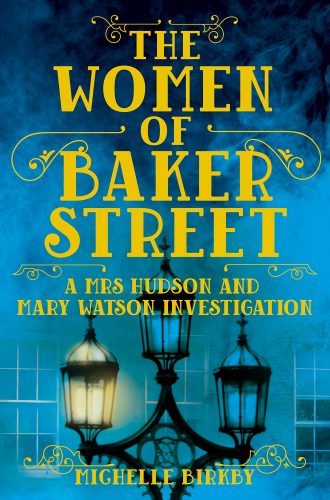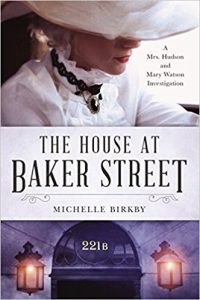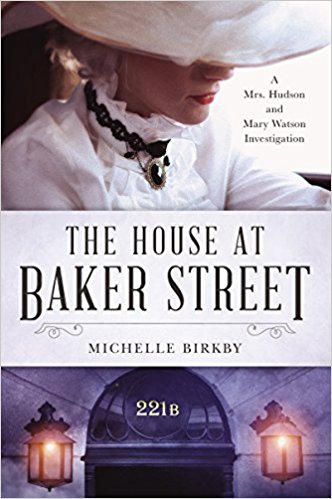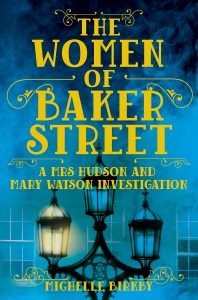 The Women of Baker Street (A Mrs Hudson and Mary Watson Investigation, #2) by Michelle Birkby
The Women of Baker Street (A Mrs Hudson and Mary Watson Investigation, #2) by Michelle Birkby Formats available: paperback, ebook
Series: Mrs. Hudson and Mary Watson #2
Pages: 368
Published by Pan Macmillan on February 9th 2017
Purchasing Info: Author's Website, Publisher's Website, Amazon, Barnes & Noble, Kobo, Bookshop.org
Goodreads
As Sherlock and Watson return from the famous Hound of the Baskervilles case, Mrs Hudson and Mary must face their own Hound, in the swirling fog of Victorian London . . .
When Mrs Hudson falls ill, she is taken into a private ward at St Barts hospital. Perhaps it is her over-active imagination, or her penchant for sniffing out secrets, but as she lies in her bed, slowly recovering, she finds herself surrounded by patients who all have some skeletons in their closets. A higher number of deaths than usual seem to occur on this ward. On her very first night, Mrs Hudson believes she witnesses a murder. But was it real, or just smoke and mirrors?
Mary Watson meanwhile has heard about young boys disappearing across London, and is determined to find them and reunite them with their families. As the women's investigations collide in unexpected ways, a gruesome discovery in Regent's Park leads them on to a new, terrifying case.
My Review:
 I read The House at Baker Street last weekend, and I loved it so much that when I discovered that the second book in the series was already available in ebook, I immediately grabbed it. Then I discovered that I simply couldn’t wait to read it, so here we are again, returning to Victorian London and 221b Baker Street.
I read The House at Baker Street last weekend, and I loved it so much that when I discovered that the second book in the series was already available in ebook, I immediately grabbed it. Then I discovered that I simply couldn’t wait to read it, so here we are again, returning to Victorian London and 221b Baker Street.
The Women of Baker Street is a direct follow up to The House at Baker Street. Events that occurred in that first book are definitely still resonating by the time this second book opens a few months later. And dogged Inspector Lestrade is still investigating the rather incendiary ending of that first story.
Much to the dismay of both Mrs. Hudson and Sherlock Holmes.
But the story in The Women of Baker Street opens in a decidedly different place, as Martha Hudson is whisked off to St. Bart’s Hospital after collapsing at home. She’s been ill for weeks, and also been successfully concealing her illness from Holmes after his return from Dartmoor, where he was off investigating the legendary Hound of the Baskervilles.
Mrs. Hudson was afraid she had cancer, and just didn’t want to know. In the 19th century, there was no hope of a cure, just suffering and death. But her problems, while serious, were much less desire. An intestinal blockage, fixed with quite survivable surgery followed by bedrest.
That’s not all there is to the case. Dr. Watson takes advantage of both his position at the hospital and Mrs. Hudson’s bent for investigation and installs her in a semi-private women’s ward where odd things have been happening. He’s not convinced that there is really anything going on, but one of the nurses whom he respects is convinced. Of course, he doesn’t believe he’s putting Mrs. Hudson at risk – his concern is to set the nurse’s mind at ease.
However, the pattern in this series is that the women’s instincts are much more accurate than the men’s logic. There IS something strange going on in that particular ward. On her very first night, Mrs. Hudson thinks she witnesses a murder. Then she chalks off her experience to pain and medication.
Until it happens again.
The first part of this case is rather quiet. Mrs. Hudson doing what she does best, sitting (or in this case mostly lying) and listening while other people expose their foibles and their secrets. The small ward is a hotbed of gossip, pain and seething resentment, all exposed to her expert’s eye over the long days that the women are all cooped up together in this single room.
When the tide of strange deaths nearly overtakes Mrs. Hudson herself, Watson and Mary whisk her back home, to continue the case, and her recovery, in a less dangerous location. At least it seems less dangerous, until Martha’s case, and the even more tragic situation that Mary has been investigating on her own, collide within the precincts of 221b. With nearly disastrous results.
The game is afoot. Until it very nearly isn’t.
Escape Rating A-: The story in The Women of Baker Street gets off to a much slower start than the previous entry in the series. Mrs. Hudson has turned out to be the prime mover and shaker in these stories, and as this entry begins, she is temporarily down for the count.
And also quite shaken. She is used to being the mistress of herself and her own domain, but as the story begins she is an invalid, stuck in a place not of her choosing and unable to take care of herself. And, of course, she hates it.
Until Dr. Watson presents her with his little bit of investigation. While she’s still not happy with her surroundings, now she has purpose – even if a part of her believes that this case has been invented to keep her at least mentally occupied.
Not that the various denizens of the ward aren’t fascinating. Especially Emma Fordyce, who was once one of the grandes horizontales of her day. She was a celebrated courtesan, lover of the rich, famous and influential, and she has never told any of the secrets that were whispered in her ears. Rumor has it she’s planning to talk.
When she dies unexpectedly, even for someone staying the hospital, it throws suspicion on anyone whose secrets she might have exposed – and on the woman who seems to have been installed in the ward solely to watch her – or to watch over her.
There were plenty of reasons still around who might want Emma Fordyce dead. But once Mrs. Hudson is home and able to take a slightly more dispassionate view of the case – all she runs into are dead ends. Including the buried bodies of a group of young boys who seem to be tied into, not the case of Emma Fordyce, but to a ghost story.
As Holmes discovered on Grimpen Mire – at the heart of all too many ghost stories lies a kernel of very nasty truth. And it is Mrs. Hudson’s dangerous investigation into the nasty truth of the so-called “Pale Boys” that brings them face-to-face with death.
Again.
The two intertwining cases turn out to be intensely chilling – to the point where The Women of Baker Street would make a good Halloween story. The creepy factor is very high, especially when added with the layers of misdirection and manipulation. And the crimes that Martha and Mary find themselves investigating just add to the chills, as does Lestrade’s continued investigation into the remnants of the case from the previous book.
No ice cube got left undribbled down my back by the end.
This is a series where I seriously want more stories, but don’t see any listed on the horizon. Which does not keep me from hoping that the author will return to Mrs. Hudson and Mrs. Watson. Soon, I hope.

 The House at Baker Street (A Mrs Hudson and Mary Watson Investigation #1) by
The House at Baker Street (A Mrs Hudson and Mary Watson Investigation #1) by  That Hudson and Watson discover in the end that evil, is in fact hunting them makes for the perfect ending – and effectively slots the first case of Hudson and Watson into the greater arc of Holmes and Watson’s long-running battle with the greatest criminal mastermind of their generation.
That Hudson and Watson discover in the end that evil, is in fact hunting them makes for the perfect ending – and effectively slots the first case of Hudson and Watson into the greater arc of Holmes and Watson’s long-running battle with the greatest criminal mastermind of their generation.